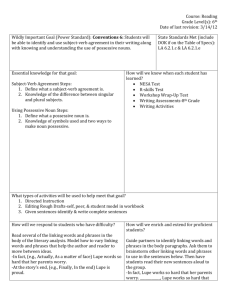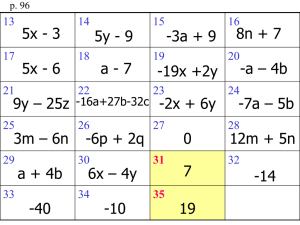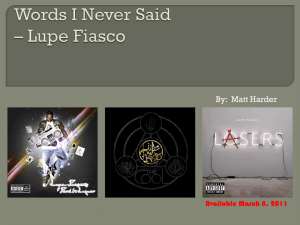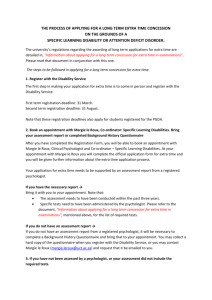Dancing Home by Alma Flor Ada and Gabriel M
advertisement
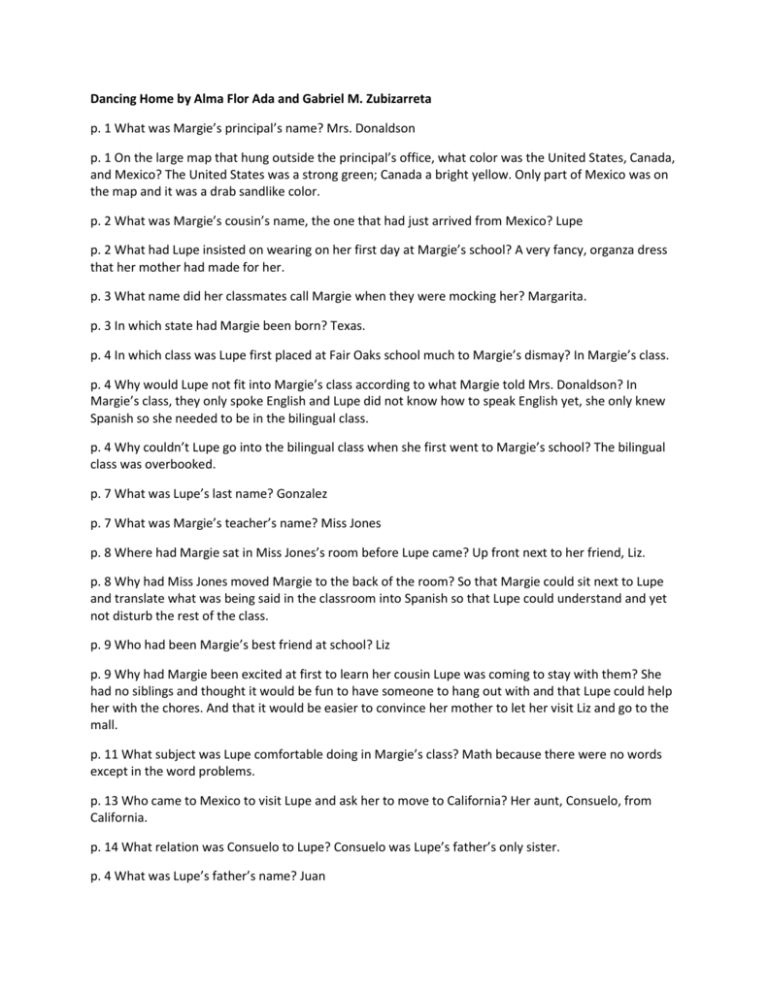
Dancing Home by Alma Flor Ada and Gabriel M. Zubizarreta p. 1 What was Margie’s principal’s name? Mrs. Donaldson p. 1 On the large map that hung outside the principal’s office, what color was the United States, Canada, and Mexico? The United States was a strong green; Canada a bright yellow. Only part of Mexico was on the map and it was a drab sandlike color. p. 2 What was Margie’s cousin’s name, the one that had just arrived from Mexico? Lupe p. 2 What had Lupe insisted on wearing on her first day at Margie’s school? A very fancy, organza dress that her mother had made for her. p. 3 What name did her classmates call Margie when they were mocking her? Margarita. p. 3 In which state had Margie been born? Texas. p. 4 In which class was Lupe first placed at Fair Oaks school much to Margie’s dismay? In Margie’s class. p. 4 Why would Lupe not fit into Margie’s class according to what Margie told Mrs. Donaldson? In Margie’s class, they only spoke English and Lupe did not know how to speak English yet, she only knew Spanish so she needed to be in the bilingual class. p. 4 Why couldn’t Lupe go into the bilingual class when she first went to Margie’s school? The bilingual class was overbooked. p. 7 What was Lupe’s last name? Gonzalez p. 7 What was Margie’s teacher’s name? Miss Jones p. 8 Where had Margie sat in Miss Jones’s room before Lupe came? Up front next to her friend, Liz. p. 8 Why had Miss Jones moved Margie to the back of the room? So that Margie could sit next to Lupe and translate what was being said in the classroom into Spanish so that Lupe could understand and yet not disturb the rest of the class. p. 9 Who had been Margie’s best friend at school? Liz p. 9 Why had Margie been excited at first to learn her cousin Lupe was coming to stay with them? She had no siblings and thought it would be fun to have someone to hang out with and that Lupe could help her with the chores. And that it would be easier to convince her mother to let her visit Liz and go to the mall. p. 11 What subject was Lupe comfortable doing in Margie’s class? Math because there were no words except in the word problems. p. 13 Who came to Mexico to visit Lupe and ask her to move to California? Her aunt, Consuelo, from California. p. 14 What relation was Consuelo to Lupe? Consuelo was Lupe’s father’s only sister. p. 4 What was Lupe’s father’s name? Juan p. 14 Why had Lupe’s father sold his family’s plot of land? To pay for the trip to El Norte so he could find a better job. Then he would send money back to his wife. p. 14 What was Juan’s first job in California? He was working in asparagus fields in Stockton, California. p. 14 What was Lupe’s mother’s name? Delores p. 16 After 3 years, what rumors reached Lupe’s mother about Lupe’s father? That he had left Stockton, CA for Chicago and had a new family there. p. 16 What job did Lupe’s mother get after she learned that Juan, Lupe’s father, had gotten a new family? She got a job preparing wool for a large rug weaver. p. 16 Where did Lupe start eating when her mother got a job at a weaver and she hardly saw her mother any longer? She went to eat at her abuelita Mercedes’ house. p. 17 Who were Pedro and Pablo? Lupe’s step brothers, twins that her mother, Delores, had with her new husband, Felipe. p. 18 Who sent Lupe two packages from the United States every year on Christmas and on her birthday? Her Aunt Consuelo from the United States. p. 19 Who was Tio Francisco? Tia Consuelo’s husband. p. 20 When had Tia Consuelo first learned that Lupe’s father had left Mexico and had headed to the United States? When one of Lupe’s mother’s brothers had written to Consuelo asking about Lupe’s father. Lupe’s father had not contacted Consuelo at all. p. 21 Who was the first person in Mexico that Tia Consuelo had talked to about Lupe coming to live with her in the U.S.? Abuelita Mercedes. p. 22 Where had Abuelita Mercedes had to move since her health had been poor? She moved in with one of Lupe’s uncles and there were many grandchildren in that house which kept Abuelita busy. p. 22 How had Tia Consuelo been able to obtain a student visa for Lupe so easily? The woman Consuelo worked for had a brother who worked for the U.S. Consulate in Mexico City and because Lupe’s uncle and aunt were now U.S. citizens, he had been able to get Lupe a student visa. p. 23 What did wearing the organza dress that her mother made her to school mean to Lupe? It was Lupe’s silent way of honoring her mother and holding her close to her heart. p. 25 When had Margie switched over to speaking English rather than Spanish? When she started the Head Start Program. p. 26 Why was Margie not able to move back to her old seat next to Liz even though Lupe got a spot in the bilingual class? Betty had moved into Margie’s old seat and Betty and Liz had become friends. So Betty did not want to be moved. p. 27 Where had Margie’s family moved from when they moved to California? Texas p. 29 What program had Margie’s father’s father, Abuelito Rafael come to the United States to work? The Bracero Program. p. 30 What was the Bracero Program? The program brought many Mexican farmers to plant and tend the fields in California, the Southwest, and all over the U.S. p. 30 How did the Bracero Program start? The family farms were bought up by huge companies who needed seasonal workers but paid low wages which few people in the U.S. were willing to work for. Laws were passed to allow growers to bring men from Mexico to work seasonally then return to Mexico. These seasonal workers were called braceros. p. 30 What were the songs that the braceros sang as they traveled across the country? Corridos de braceros. p. 31 What about Lupe became a symbol to Margie of all the changes that were making Margie’s life so difficult? Lupe’s braids. Margie was envious of the bond Lupe and Margie’s mom formed as Margie’s mom combed and braided Lupe’s hair. p. 32 Why had Margie wanted a perm at the start of the school year? Because she saw that a head of brown curls was an ideal image of a true American girl. p. 33 What was the name of Lupe’s teacher in the bilingual class? Mrs. Rodriguez. p. 34 What did abuelita’s saying “Lo que no te mata, te hace mas fuerte” mean? What doesn’t kill you, makes you stronger. p. 35 For Lupe, what was hardest about being surrounded by a new language? The feeling of being left out. p. 35 What grade was Lupe in? Fifth grade. p. 36 What were some of the dreams that Lupe began having that upset her? In one, she was reciting a poem before an assembly of students and teachers of her new school but no sound came out except she began to quack like a duck. In another dream, she was walking in her old school and her school uniform fell away leaving her only in a cotton slip. In another dream, everything was upside down and inside out. p. 36 What did Lupe love most about her room? The feeling of safety she experienced there. p. 38 What would Lupe have to often do to help her fall back asleep after one of her dreams awakened her? Sing in her mind some of the songs she used to sing on the playground. p. 41 Why was Lupe going to stay after school on Tuesdays and Thursdays? She was joining a folklorico dance group. p. 41 Why did Margie’s mother ask Margie to stay after school on Tuesdays and Thursdays? So she could walk home with Lupe after her folklorico dance group meeting. p. 43 Who was the new student that joined Margie’s class after Lupe moved to bilingual class? Camille, a tall blond girl. p. 43-44 What was the special project that Miss Jones wanted the class to do for their last year in elementary school? To write in a journal but a topic of personal interest, a topic they felt passionate about, an issue that was very important to them. p. 45 What was Camille’s passion? Dolphins p. 46 What type of dolphin was most commonly seen in captivity? Atlantic Bottlenose Dolphin p. 46 What species was Camille’s favorite dolphin? The Commerson’s dolphin. p. 47 What did it mean that dolphin pods were matriarchal? The leading dolphin was an older female who has had many offspring while the older males were at the bottom of the social order. p. 52 Who stayed after school with Margie to wait for Lupe to get out of her dance group? Camille p. 52 What did Camille and Margie begin doing as they were staying after school waiting on Lupe? They became helpers at the library, reshelving books. p. 53 What was the librarian’s name? Ms. Faggioni p. 53 What were some of Camille’s favorite books? My Side of the Mountain, Julie of the Wolves, Hatchet, but her favorite was Island of the Blue Dolphins. p. 53 What series did Margie begin to read at the library? The Redwall series. p. 54 What would Margie do if she found a word she didn’t know while reading? She loved to look up words in the dictionary. p. 54 What was almost like a game to Margie, a treasure hunt? Searching for new words to look up. p. 55 What was Lupe’s greatest fear? That Margie might resent having to share her home and parents with Lupe. p. 57 What had been Margie’s favorite time of year? Christmas p. 57 What Christmas carol did Margie like to sing to herself while falling asleep? Silent Night p.58 When was the first time Margie had seen her mother cried? When Margie had fussed to her that they didn’t have a Christmas tree like everyone else and that her mother was always listening to the Spanish radio channel so how was Margie going to learn to sing Christmas carols. p. 58 What did Margie get that Christmas when her family first bought a tree? A CD player with 2 CDs with Christmas carols. p. 60 What change were Margie’s parents making this Christmas that made Margie particularly upset? That they would have a nativity scene(nacimiento) rather than a Christmas tree. p. 61 What artist did Lupe have a book on and that the calla lilies on their table reminded her of? Diego Rivera p. 63 Who were Melchor, Gaspar, and Baltasar? The Three Wise Men or los Reyes Magos. Melchor rode a camel and was from Arabia. Gaspar rode a horse from Persia. Baltasar rode an elephant from Africa. p. 65 What was the play that the townspeople in Lupe’s town in Mexico would perform every Christmas? La pastorela, an old traditional play about the shepherds. p. 66 When did the children in Mexico receive their gifts during the holiday season? On January 6, el dia de los Reyes Magos. p. 68 What did Margie want for Christmas that she was disappointed that she didn’t get? An ipod but she did get a pair of rollerblades and a new backpack. p. 68 What did Lupe get for Christmas? A wooden artist’s box. p. 70 What had Camille done over the Christmas break? She had gone to Florida to visit her grandmother and then they went to the Florida Keys. They swam with dolphins and were trainers for a day at a marine-life park. p. 71 What invitation did Camille make to Margie and Lupe? To go with Camille’s family this Sunday to Discovery Kingdom in Vallejo. Camille had been there so often that she knew some of the trainers and they would get to speak to them between shows. p. 73 Why did Camille want to start speaking Spanish? Half of her family spoke Spanish – some of her father’s family were from Cuba and her grandfather was from Peru. p. 76 Who were Jessica and Collette? Camille’s sisters who went to the marine life park with Margie and Lupe. p. 77 What did Camille’s father like about celebrating both Christmas and el Dia de los Reyes Magos on January 6? He got two sets of presents. p. 80 When was the first time that Margie had felt truly happy since Lupe had come to live with them? When they went to the marine park with Camille’s family. p. 80 What was Lupe’s wildest dream that came true? She got to ride an elephant when she visited the marine park with Camille’s family. p. 81 Which of the three wise men did Lupe think brought her presents on el Dia de los Reyes Magos? Baltasar because he rode an elephant. p. 81 How did being happy affect people’s ability to learn languages according to what Margie wrote in her journal? Being happy helps people learn languages and do other things better. p. 83 What book did Lupe choose from the library when the substitute teacher took the class there? A book on elephants. p. 84 Which of Camille’s sisters did Lupe enjoy being with? Jessica. p. 84 What did Jessica carry around with her that made Lupe realize she could do the same? A sketch pad and coloring pencils. Jessica liked to draw as much as Lupe did/ p. 84 What type of animals did Jessica tell Lupe that she liked the best? Sea dragons. p. 85 Where did sea dragons come from? The Australian ocean. p. 89 What did Mrs. Rodriguez want Margie to do one day after school? Fill in folklorico dancing for Vanessa who was ill. p. 91What did Mrs. Rodriguez want Margie to do once Vanessa returned to the folkorico dancing? To fill in for Lucy who was now sick. Mrs. Rodriguez wanted Margie to be the understudy. She could fill in for another dancer if they were missing a class. p. 94 What did Margie’s Spanish name, Margarita, mean? Daisy. Her mother named her for her favorite flower. Her mother thought daisies were precious, happy flowers. p. 95 Who wrote the Spanish poem that Lupe said was about a girl with Margie’s Spanish name, Margarita? Ruben Dario. p. 95 In the Ruben Dario’s poem, what type of palace did the king live in? One made of diamonds and he had an entire herd of elephants. p. 96 What was the name of the Ruben Dario poem that Lupe told Margie about? To Margarita. p. 96 In the poem, To Margarita, what did Margarita do regarding the star? The princess, Margarita, went all the way to the heavens to pick a star. p. 96 Why didn’t Margie like to use her Spanish name according to what she told her parents? People didn’t know how to pronounce it. Even the teachers didn’t get it right. p. 98 Who was the man who called up to Margie’s house but hung up when she answered the first time? Juan, Lupe’s father. p. 99 Who was the man who visited Margie’s house and had a cast on his leg? Juan, Lupe’s father. p. 99 Where was Margie’s mother taking classes at? The community college. p. 101 Why did Lupe not recognize her father at first when he came to Margie’s house? He was overweight and his leg was in a cast. p. 102 What was Lupe’s father’s name? Juan Gonzalez. p. 102 Where had Juan gone after he left Chicago? He moved to Texas because he couldn’t face another Chicago winter. p. 102 Why had Juan come to his sister’s house? He had used most of his savings to pay for the Xrays and cast for his leg. He had come to heal at his sister’s home because he was out of money. p. 103 How had Juan hurt his leg? In a tractor accident in Napa, not far from where Margie’s family lived in Santa Rosa. p. 108 What was Lupe’s stepsister’s name, her father’s new daughter? Xochitl p. 108 Why had Lupe’s father named his new daughter Xochitl? It was the name of Lupe’s doll and he hoped she would love her new sister as much as she had loved that doll. p. 112 What did Lupe’s father make for breakfast? Huevos rancheros, tortillas, and pan dulce. p. 114 Why didn’t Lupe want to go to Texas to live with her father? She said she belonged with Tia Consuelo’s family, Margie’s family. Her English was improving and she was doing well at school. She didn’t want to start all over again. p.115 Who were Lupe’s three families? Tia Consuelo, Tio Francisco and Margie were one. Her mother in Mexico, Delores with her new husband and twins were another. Her father, Juan, and his wife, daughter, and son who lived in Texas were another. p. 117 What was Consuelo and Francisco’s farewell gift to Juan? A guitar. Juan’s old guitar had been stolen in Chicago. p. 118 On what occasion would the girls have their big folklorico dance performance where they would showcase the dances they had learned all year? Cinco de Mayo p. 122 What did the delivery woman bring to Margie’s house? A large package that contained Lupe’s folklorico dance dress and a surprise dress for Margie too. They were made by Delores, Lupe’s mother. p. 123 What program was Consuelo thinking about entering once she finished two more semesters of English? A dental hygienist program. p. 124 What color was Lupe’s folklorico dance dress? Purple with ribbons of different shades of violet and pink. p. 125 What color dress did Delores make for Margie? White with red and blue ribbons – white like the flower she was named after and red and blue for the country where she was born. p. 129 What poem did Lupe recite before the folklorico dance on Cinco de Mayo? Ruben Dario’s poem “A Margarita”. p. 131 What did the poem “A Margarita” call the star that Margarita had brought home from the heavens? The star was “una flor de luz” a flower made of light. p. 134 What grade was Margie in when her parents moved from Texas to California? Second grade. p. 134 In which state was Margie born? Texas p. 137 Why did Margie say she was Mexican as well as American? She said she was Mexican because her parents were Mexican. p. 143 Why did Margarita in the poem want to get a star? For the brooch that she was making with a poem, a pearl, a feather, and a flower.



